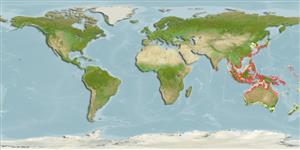Malacostraca |
Decapoda |
Portunidae
Environment: milieu / climate zone / depth range / distribution range
Ecology
Benthic. Tropical
Indo-West Pacific: northern parts of South China Sea and parts of Java.
Length at first maturity / Size / Weight / Age
Maturity: Lm 10.2 range ? - ? cm Max length : 20.0 cm CW male/unsexed; (Ref. 343); max. published weight: 2.00 g (Ref. 343)
Carapace usually green to light green, palm green to greenish blue with lower surface and base of fingers usually pale yellow to yellowish orange.
Common carapace width: between 15 and 18 cm. Found intertidal to subtidal. Associated with shallow reef rubble, subtidal flats and estuarine pools, or in mangrove forests (Ref. 125642).
Life cycle and mating behavior
Maturity | Reproduction | Spawning | Eggs | Fecundity | Larvae
Members of the order Decapoda are mostly gonochoric. Mating behavior: Precopulatory courtship ritual is common (through olfactory and tactile cues); usually indirect sperm transfer.
Ng, P.K.L. 1998 Crabs. p. 1045-1155. In K.E. Carpenter and V.H. Niem (eds) FAO species identification guide for fishery purposes. The living marine resources of the Western Central Pacific. Volume 2. Cephalopods, crustaceans, holothurians and sharks. Rome, FAO. 1998. pp. 687-1396. (Ref. 343)
IUCN Red List Status
(Ref. 130435: Version 2025-1)
CITES status (Ref. 108899)
Not Evaluated
Not Evaluated
Threat to humans
Harmless
Human uses
| FishSource |
Tools
More information
Trophic EcologyFood items (preys)
Diet composition
Food consumption
Predators
PhysiologyOxygen consumption
Human RelatedStamps, coins, misc.
Internet sources
Estimates based on models
Resilience
High, minimum population doubling time less than 15 months (K=2.39; tm=0.49).
Fishing Vulnerability
Low vulnerability (10 of 100).
Price category
Unknown.
